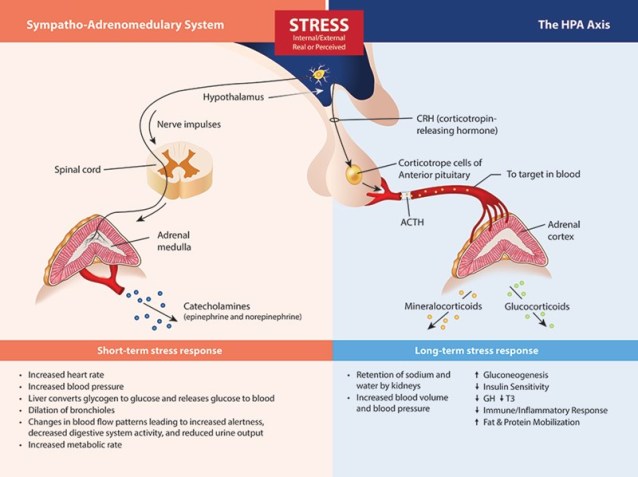Sometimes you have to ask, is this stress healthy and normal? People may easily declare NO but most of the time, stress includes what you don’t say or the nonverbal cues. Stress can lead to anxiety or depression in addition to other conditions and is somewhat similar to hypertension as a “silent killer”.
Although palpitations and profuse sweating are associated with anxiety, hidden signs are truly the devastating effects. Anxiety can dysregulate the body’s chemistry and other important organs. The pathology mainly focuses on the stress response because that event alone causes a cascade of problems and diseases. It’s one of the main reasons why anxiety and stress should not be ignored.
An Overview & Statistics
- Anxiety affects >23million per year (~1/4 of the population). Groups at higher risk include: those with lower socioeconomic resources, family history, being divorced or widowed, minority children, women>men
- Subcategories: Generalized Anxiety Disorder, Obsessive-Compulsive Disorder (OCD), Panic Disorder, Post-Traumatic Stress Disorder (PTSD), Social Phobia (or Social Anxiety Disorder)
- Normal Anxiety: is an adaptive emotion that consists of a temporary response to the environment or circumstance. You might feel anxious when faced with a problem, before taking an exam or making important decisions. Occasional anxiety is a normal part of life.
Signs and Symptoms of Anxiety
- Abnormal anxiety is paralyzing and embarrassing, it does NOT go away or it gets excessive and becomes maladaptive. These agonizing feelings can interfere with activities of daily living such as job performance, school work, and relationships.
- There are many symptoms of anxiety but overall it includes trouble controlling their worries or feelings of nervousness, hard time concentrating, easily startled, trouble falling asleep or staying asleep unexplained pains, and complaints.
- The main core symptoms are worry and fear. The difference is that “fear” has a cause whereas the source of anxiety goes unrecognized.
Etiology of Symptoms

Beginning in the brain, stress signals are communicated by direct innervation to the adrenal medulla to cause a nearly immediate release of catecholamines (the fight or flight response) and through neuro-hormone signals within the HPA axis that influence the release of cortisol, DHEA(S) and aldosterone –Lifestyle Matrix
Anxiety’s Phenotype
(deconstruct the syndrome into brain regions and circuits; where medications i.e. SSRI can target)
- Fear: panic, phobias
- Amygdala centered circuit
- Neurotransmitters: 5HT, GABA, glutamate, CRF/HPA, NE, voltage-gated ion channels
- Worry: anxious, misery, apprehension, expectation, obsession
- Cortico-striatal -thalamic- cortical circuit “the worry loop”
- Neurotransmitters: 5HT, GABA, DA, NE, glutamate, voltage-gated ion channels
Stahl, 2013
Key Points
- Stress is perceived as a threat by the limbic system ->neurons in the limbic system activate the HPA axis, which mobilizes the “fight or flight system” -> early experience and stress -> maladaptive or increased stress levels.
- If cortisol levels stay high for too long, it starts to harm the hippocampus, so it’s not as effective at deactivating HPA (in addition to damage caused by cortisol to other organs).
- Hypothalamus-pituitary-adrenal Axis (HPA) System is very important when understanding the stress response and how anxiety becomes pathological. This is why and how medications are useful and necessary.
- Progressive damage caused by cortisol (fat) to the other organs and vessels may account for how anxiety has physical and painful symptoms and not just psychological trauma.

Medical Conditions that May Mimic Anxiety
- Cardiovascular: CHF, mitral valve prolapse, MI, (tachycardia) arrhythmias, pulmonary emboli, CAD
- Endocrine: Cushing’s disease, hyperthyroidism, hyperparathyroidism
- Metabolic: hypoglycemia, vitamin B deficiency, porphyria
- Neurological: seizure disorder, TIA, CVA, encephalitis, CNS neoplasms
- Respiratory: asthma, COPD, pneumonia
- Substances: CNS stimulants (cocaine, amphetamines, caffeine) & withdrawals (EtOH)
Understanding and Implications
- Identifying the difference between normal and healthy stress versus debilitating anxiety is imperative with treatment and prognosis. Fear and anxiety usually have a cause, unlike worrying. Make sure to rule out serious medical reasons.
- Anxiety disorders have more favorable outcomes with cognitive behavioral therapy than with medications alone. Promote healthy sleep hygiene and target serotonin, NOT GABA receptors.
- Encourage substance and alcohol cessation, which frequently accompanies anxiety disorders.
- Assist and provide social support and resources.
Additional Information & References
Stress-Management Techniques
- Stress management techniques and meditation can help people with anxiety disorders calm themselves and may enhance the effects of therapy. While there is evidence that aerobic exercise has a calming effect, the quality of the studies is not strong enough to support its use as a treatment. Since caffeine, certain illicit drugs, and even some over-the-counter cold medications can aggravate the symptoms of anxiety disorders, avoiding them should be considered. Check with your physician or pharmacist before taking any additional medications.
- The family can be important in the recovery of a person with an anxiety disorder. Ideally, the family should be supportive but not help perpetuate their loved one’s symptoms.
Free Booklets and Brochures
- Generalized Anxiety Disorder (GAD): When Worry Gets Out of Control: A brochure on GAD that explains the signs, symptoms, and treatment
- Obsessive-Compulsive Disorder: When Unwanted Thoughts Take Over: A brochure on OCD that explains the signs, symptoms, and treatments
- Panic Disorder: When Fear Overwhelms: a brochure on panic disorders that explains the signs, symptoms, and treatments
- Social Anxiety Disorder: More Than Just Shyness: This brochure discusses symptoms, causes, and treatments for social anxiety disorder (also called social phobia).
Multimedia
- Watch: Bullying Exerts Psychological Effects into Adulthood– Once considered a childhood rite of passage, bullying is no longer seen as benign. Its effects linger well into adulthood. Bullies and victims alike are at risk for psychiatric problems such as anxiety, depression, substance abuse, and suicide when they become adults, according to a study partially funded by the NIMH that was published in the April 2013 issue of JAMA Psychiatry.
- See: Multimedia about Anxiety Disorders
–The National Institute of Mental Health Information
Quick Links

